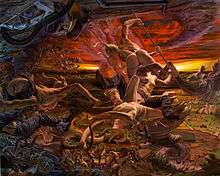Nicola Verlato
| Nicola Verlato | |
|---|---|
| Born |
Nicola Verlato February 19, 1965 Verona, Italy |
| Nationality | Italian |
| Education | Monastery of Lonigo |
| Known for | Painter |
| Awards | Bevilacqua La Masa Foundation residency (1995) |
Nicola Verlato (born February 19, 1965) is an Italian-American painter, sculptor, architect and musician based in Los Angeles, California.
Early life & Education
Nicola Verlato was born in Verona and began painting at a very early age, learning from Fra' Terenzio, a painter in the monastery of Franciscan monks of Lonigo. He was trained in Classical music and studied lute and composition at the conservatories of Verona and Padua. He studied architecture at University IUAV in Venice from 1984 to 1990, though he never completed his degree.
Biography
Early career (1980–2004)
His first serious show was at the age of 15 in the town hall of Lonigo, a 3-person show in collaboration with other 2 artists of the area. After moving to Venice, he began working for the local aristocracy and the affluent foreigners living in the city. During this period, besides painting, he also worked on almost everything that was connected with drawing: stage design, temporary decorations, illustrations, comics, storyboard etc. In 1995, he won an artist residency at Fondazione Bevilacqua La Masa.[1] Around 28 years old, he started to be involved in contemporary art scene, and, consequentially, to show in numerous gallery in Italy and abroad in solo and group shows. In 1996, Verlato moved to Milan where he created his well grounded notoriety in Italy. In the same year, he exhibited his work at XII Quadrinnale [2] at Palazzo delle Esposizioni in Rome.

United States (2004–present)
In 2004, Verlato relocated from Milan to New York City. While living in New York, he was a professor teaching composition and painting courses at New York Academy of Art. He has shown his paintings, drawings, and sculptures in the United States and internationally, including the White Columns[3] in New York, Museum of Moder Art in Arnhem, Prague Biennale,[4] and an installation exhibited at the 2009 Venice Biennale in the Italian Pavilion. His works are in the permanent collection at MART [5] in Trentino, MUSAC [6] in León, and MUDIMA Foundation [7] in Milano.
Nicola Verlato creates his works through an articulated process that makes use of classical techniques as well as modern technology such as 3D Modeling programs such as Maya and ZBrush.
In a 2012 interview with Nicola Verlato, he said
"In my opinion CG is liberating images from the conceptual boundaries of four-centuries-old latent, or declared, iconoclasm, which considers images as false in those cases where they are not documents of an external reality.
If photography was the technological result of those centuries of religious and philosophical devaluation of the role painting held in creating the sacred, all in favor of the written word, then computers, as they are used today in different fields of entertainment, are restoring our trust in images. This recent explosion of new drawings and paintings which is pervasive on the Internet (but not yet in museums) could be explained by this renovated trust in images.
I started being interested in CG since I first saw Tron in movie theaters, back in 1982. What struck me was the obvious similarity between that new way to create images and the one of the fifteenth-century perspective, it seemed to me that it was possible, on a new level of complexity, to pick back up from where the masters of the Renaissance left off. The problem was that there was no way for a seventeen-year-old painter to get in touch with what was, at that time, extremely expensive technology. Almost ten years passed before I was able to get my hands on a PC and a 3D program to work with. The use of computers didn’t change my approach to painting, it just expanded the scope of what I can introduce in the representations and how much control I have over it.
I can now virtually introduce any element of our world—engineering structures, complex architectures, design objects—into the painting, as well as controlling difficult foreshortening and the reconstruction of faces with the added possibility of animating them. The real world can be put once again into the painting and manipulated to create new narrations and icons."[8]
Nicola Verlato has shown alongside artists such as Shepard Fairey, Mark Ryden, Robert Williams, Todd Schorr, and Eric White. His work can be found in private and public collections such as Jack Helgesen collection (Norway), M.A.R.T. Museum (Rovereto).
His work has been published in Art in America, Flash Art, Juxtapoz, Hi Fructose, Vogue Italia, Art Pulse, and LoDown Magazine and more.
Publications
- NICOLA VERLATO From Verona with Rage, Gingko Press, (2013).
- The Figure, New York Academy of Art,